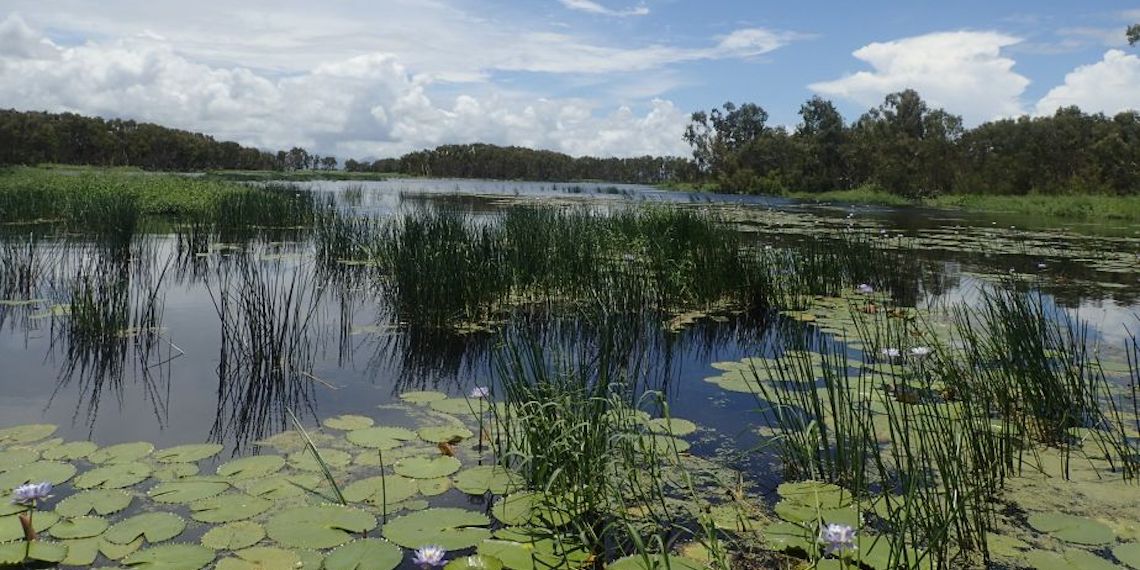Natural weed control restores health of freshwater wetlands

Restoring the health of freshwater coastal wetlands that have been inundated with weeds can be achieved by removing manmade sea barriers, according to recent research that accurately predicted the outcomes of this method via hydrodynamic modelling.
In collaboration with the CSIRO, James Cook University’s Dr Nathan Waltham from the Centre for Tropical Water and Aquatic Ecosystem Research led the research team on the study investigating natural approaches to weed control.
Waltham said bunds, or embankments, were built decades ago to close off freshwater sources from the sea and provide water for cattle. However, these areas now suffer from poor water quality and are heavily infested with freshwater weeds.
“Widespread use of herbicides to control weeds has resulted in environmental issues and has led to the search for more natural control methods such as using saline water,” he said.
“Our study involved the proposed removal of a bund separating the Mungalla wetland in Queensland from the sea and allowing the salt water to do the job for us instead of using chemicals.”
Wetland preservation through hydrodynamic modelling
Recent advancements in computational methods have allowed for hydrodynamic modelling that can reliably predict the outcomes of removing the bund, Waltham said.
“We obviously wanted to assess what was likely to happen in advance of committing to extensive earthworks, so we carried out simulations of 11 different scenarios under different tide, onshore wind, low atmospheric pressure and sea level rise conditions,” he said.
Removing wetland weeds improves water quality
The simulations conducted indicated favourable outcomes and the bund wall was removed, resulting in improvement in water quality, leading to the reduction of freshwater weeds.
“Few wetland restoration projects in the past have gone as far as reintroducing seawater, mainly because of uncertainties in the extent, frequency and duration of seawater ingress after removing man-made obstructions,” Waltham said.
The study showed simulations can now be used to determine the potential impact of various interventions before committing to action.
“For example, the removal or height adjustment of tidal barriers, the dredging of silted streams, the removal of weeds from choked streams and the reintroduction of tidal flows can now all be modelled beforehand,” Waltham said.
The study also showed that the restriction of tidal flushing onto coastal wetlands, as well as intersecting creeks by roads, pipelines, floodgates and culverts, has negatively impacted wetland productivity and detrimentally impacted local birds, fish and plants.
“What is most interesting here is that under current sea levels the tides will inundate the wetland now several times each year, less during above average rainfall wet seasons,” Waltham said.
“However, in the future under sea level rise more large tides are expected, which makes this research even more critical for restoration and management of sensitive coastal wetland.”
Wetlands management and conservation
Waltham said the increasing efforts to rehabilitate coastal wetlands by removing man-made barriers in recent decades will likely continue in light of ecosystem restoration commitments instigated by the UN.
“These efforts will only increase following the UN’s recent declaration of a decade on ecosystem restoration — and now we have the tools to make it much more effective, which is really exciting given the opportunities of blue carbon that these kinds of restoration work offer us as we face climate change and sequestration of carbon from the atmosphere,” he said.
The study was funded by the Australian Government’s National Environment Science Program Tropical Water Quality Hub.



